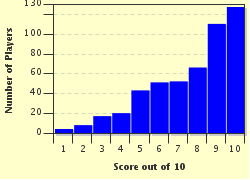Quiz Answer Key and Fun Facts
1. Burkina Faso was named Upper Volta until 1984. The old name was due to Burkina Faso being home to the headwaters of three waterways called the Volta River. The rivers were each given an extra name to differentiate them. What are the three Volta Rivers called?
2. The waters of the three Volta Rivers enter which large body of water in Ghana before emptying into the Atlantic Ocean?
3. Burkina Faso, like Algeria, is a significant exporter of crude oil.
4. While you're in the capital of Burkina Faso, Ouagadougou, you could visit Our Lady of the Immaculate Conception Cathedral. It's built of a traditional material used in the area. What is the cathedral made of?
5. Part of Burkina Faso is dedicated to the W National Park which extends over three countries. What was the W National Park named after?
6. Burkina Faso is a fairly flat country, much of which consists of rolling plains. Which part of the country is made up of a sandstone massif and includes the highest peak, Ténakourou?
7. The Domes of Fabedougou are a tourist attraction near the town of Banfora. What are the domes?
8. Burkina Faso is a very dry country with rain falling mostly in a four month period. What topsoil isn't blown away by winds in the dry season can be washed away during the rainy season. What have the Burkinabe been doing to reduce soil erosion during the rainy season?
9. In the southwest corner of Burkina Faso at a place called Loropéni lies a UNESCO World Heritage Site. What can be seen at Loropéni?
10. While sightseeing in Burkina Faso, you decide to visit Lake Tengrela, hoping to see the wildlife it's famous for. Which particular animals are a tourist attraction in Lake Tengrela?
Source: Author
Tizzabelle
This quiz was reviewed by FunTrivia editor
Exit10 before going online.
Any errors found in FunTrivia content are routinely corrected through our feedback system.

